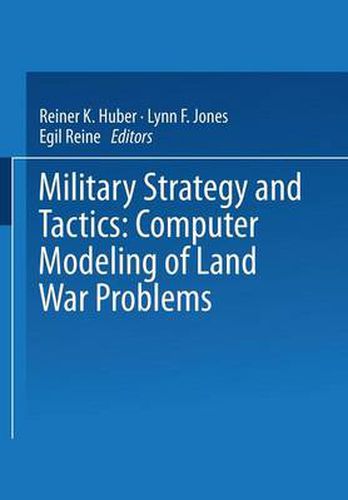Readings Newsletter
Become a Readings Member to make your shopping experience even easier.
Sign in or sign up for free!
You’re not far away from qualifying for FREE standard shipping within Australia
You’ve qualified for FREE standard shipping within Australia
The cart is loading…






This title is printed to order. This book may have been self-published. If so, we cannot guarantee the quality of the content. In the main most books will have gone through the editing process however some may not. We therefore suggest that you be aware of this before ordering this book. If in doubt check either the author or publisher’s details as we are unable to accept any returns unless they are faulty. Please contact us if you have any questions.
This volume brings forth a set of selected papers from the Conference on Modeling Land Sattle Systems for Military Planning. Sponsored by the Special Programme Panel on Systems Science of the NATO Science Committee, the conference took place in Ottobrunn, Germany, at the War Gaming Centre of Industrieanlagen-Betriebsgesellschaft. The idea to organize a conference on land battle systemmodelswas first suggested to me in 1g72 by Andreas Mortensen, then a member of the Norwegian Defence Research Establishment and presently at the SHAPE Technical Centre, when we discussed the apparent inconsistencies of various evaluations of force capability within NATO. Frequently, decision makers are confronted by contradictory results of different studies addressing essentially the same problern leaving them with the impression that the tools of systems analysis and operations research may not be very objective guides. However, experienced systems researchers know that a detailed comparison of models, their assumptions and inputs, would generally show that results are not really contradictory. But not only seem the decision processes in large national and international organizations tobe suchthat a comparison can hardly ever be accomplished, also the docu mentation available is rarely sufficient to really camprehend the differences in results. For these reasons, we felt that an effort to review the state of the art of model ing in support of force capabil ity assessments was overdue.
$9.00 standard shipping within Australia
FREE standard shipping within Australia for orders over $100.00
Express & International shipping calculated at checkout
This title is printed to order. This book may have been self-published. If so, we cannot guarantee the quality of the content. In the main most books will have gone through the editing process however some may not. We therefore suggest that you be aware of this before ordering this book. If in doubt check either the author or publisher’s details as we are unable to accept any returns unless they are faulty. Please contact us if you have any questions.
This volume brings forth a set of selected papers from the Conference on Modeling Land Sattle Systems for Military Planning. Sponsored by the Special Programme Panel on Systems Science of the NATO Science Committee, the conference took place in Ottobrunn, Germany, at the War Gaming Centre of Industrieanlagen-Betriebsgesellschaft. The idea to organize a conference on land battle systemmodelswas first suggested to me in 1g72 by Andreas Mortensen, then a member of the Norwegian Defence Research Establishment and presently at the SHAPE Technical Centre, when we discussed the apparent inconsistencies of various evaluations of force capability within NATO. Frequently, decision makers are confronted by contradictory results of different studies addressing essentially the same problern leaving them with the impression that the tools of systems analysis and operations research may not be very objective guides. However, experienced systems researchers know that a detailed comparison of models, their assumptions and inputs, would generally show that results are not really contradictory. But not only seem the decision processes in large national and international organizations tobe suchthat a comparison can hardly ever be accomplished, also the docu mentation available is rarely sufficient to really camprehend the differences in results. For these reasons, we felt that an effort to review the state of the art of model ing in support of force capabil ity assessments was overdue.